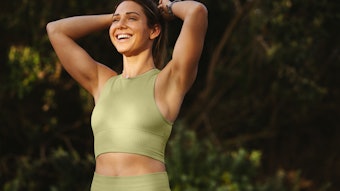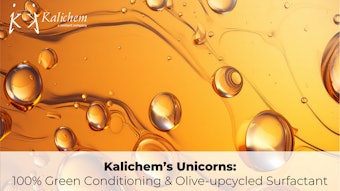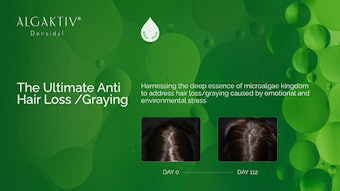
According to The Benchmarking Company's new "The Age of Naturals" report, 93% of all women might or would be willing to try a new beauty brand if it earned the USDA Organic Seal. When asked to check reasons (among many) why women buy natural/organic beauty products, 80% said they were better for their skin and 64% cited they didn’t want chemicals on their skin as their top two reasons. Another 27% cited that the ingredients in traditional beauty products were harmful to her health.
“Consumers have been inundated with headlines focusing on lead in lipstick, off-label uses of pharmaceuticals in cosmetics, the potential perils of parabens and other ingredients, Chinese product recalls and global warming caused by manmade toxins. But nowhere has the fear of ingredients been felt more acutely than in the beauty industry,” said Alisa Marie Beyer, president and CEO of The Benchmarking Company. “Consumer demand for natural and organic beauty brands may just be the single most important issue to impact the beauty industry in its history.”
The wide-ranging report, the first of The Benchmarking Company’s Pink Reports™ of the year and the most comprehensive of its kind, covers women’s natural and organic beauty brand motivations, fears, attitudes, purchasing habits, marketing preferences, willingness to explore inside/out beauty offerings, believability of manufacturer’s claims, overall trust factors, shopping habits, and specific reasons why certain brands are purchased and certain brands are overlooked, as well as comprehensive buyer profiles. More than 80 natural and organic skin care, makeup and hair care brands were tracked for this study.
“Our goal in developing this study was to offer a complete blueprint for beauty brands that market natural or organic products to women. Too often, studies are one-dimensional, offering a sea of sales data or limited consumer points of view,” explained Beyer. “The Age of Naturals explores not only a well rounded picture of women who are natural beauty buyers already, but we offer valuable data from non-naturals buyers to arrive at a clear view of why women do and do not buy a brand or trust a manufacturer. When a brand has both sides of detailed consumer viewpoints, marketing changes can be made to keep current buyers while gaining new ones.”
Highlights of the report include:
· 61% of all women agree it is difficult to tell which beauty brands are natural or organic and which are not.
· 93% of all women might or would be willing to try a beauty brand if it has earned the USDA Organic Seal.
· Women want to feel safer, and 89% of them feel that companies should be more forthcoming about which products are truly natural and which are not. Ingredients she’s particularly leery of include artificial fragrances (54%); silicone (43%) and gluten (34%). Parabens are not wanted in cosmetics by a quarter of naturals buyers and only 15% of traditional buyers; and hydroquinone is unwanted by 21% of natural buyers and 11% of traditional buyers.
· When thinking about beauty products, the term “-FREE”, meaning free of harmful chemicals, etc.) was her top choice as most appealing terminology on a beauty label at 73%. Terms like clean, antioxidant, natural, and hypoallergenic followed. Her least favored terms, from a list of 17 choices, are: therapeutic 40%, radiant 37%, dermatology 32% and science, dead last at 9%.
· Women were asked to rank their believability of 7 actual beauty brand claims. The claims she felt were most believable were those with a clear explanation of nature’s benefits to her skin using soothing, fresh and natural language. Claims using clinical terms and statistics left her cold and she found them least believable.
· Women are very in-tune to the socially and ethically responsible activities of corporate America, and she is becoming more interested in how responsible her beauty manufacturers are as well. When considering purchase decisions, she places great importance on a company’s stance on animal testing, recycling, and the use of sustainable products, below. Most women (87%) have never read a Corporate Social Responsibility report from a beauty manufacturer, although 57% of those who hadn’t indicated they would be interested in doing so.
· When asked which manufacturer’s product she would be more likely to trust as natural or organic between a new product made from a small company that ONLY makes natural or organic beauty products and a new natural/organic beauty product made from a well-known maker of traditional beauty products, 29% of all respondents said they would more readily trust the smaller natural/organic only product maker. Thirty-one percent of respondents would trust both types of companies equally, 22% would trust a well-known maker of traditional beauty products and 18% would be skeptical of both types of companies.
· Women are most eager to try (74%) a consumable beauty product that can be eaten “on the go” and 72% would prefer a beauty supplement in a pill or capsule form. The least favored delivery system for a nutricosmetic was a drink made from a powder, with 52% of women saying they would not be willing to try it.
· If there was a cosmetic watchword for 2007, that word was “mineral.” Forty-three percent of all women say they currently use mineral makeup, and 76% of all women believe it to be a natural product. They use it because it really works and is natural (50%) and they also feel it is safe for their skin (49%). For the 57% who don’t currently use mineral makeup, it’s just a matter of time. Thirty-four percent of those who don’t use it aren’t yet having any problems with their current brand. Those who don’t use it have very little negative comments about it—they feel that mineral is credible.
· While mass brands are the most widely used, Bare Escentuals holds a special place in her heart and wallet. Seventy-three percent of all women know the brand; 26% use it; 24% feel it is the BEST makeup product on the market— regardless of price—and 33% would recommend it to a friend.
· When women were asked if there was something they wished their current natural/organic brand did, but does not currently do, the response was very clear. Women simply want more buying options. Beyond the usual “I wish it was less expensive” response given by 69% of respondents, 38% wish it was easier to find or buy; 36% want sampler sets; 22% want complimentary products for other areas of their bodies; 17% want gift sets, and 12% wish it offered complimentary products for other members of their families. Wanting the product to work more effectively came in at 14%.
· When asked which retail outlets she trusts most to purchase beauty products that are natural/organic, 37% felt special beauty stores lead the pack, followed by local health food stores (31%), natural foods stores (30%), superstores and the Internet (27%), and specialty grocery stores (22%).
The 123 page study tracks women’s opinions on more than 80 natural/organic beauty brands, showcases the five top study vitals, provides a section summary with forward thinking Pink Predictions™, includes 72 tables and charts and hundreds of data points critical to marketing decision-making. The study is divided into chapters covering a detailed consumer profile, her self care and family care routine, her natural/organic knowledge base, her attitudes and beliefs about natural/organic cosmetics and their claims, natural/organic brands she knows, loves and dislikes, her attitudes toward inside/out beauty and her willingness to try nutricosmetics and cosmeceuticals, and her brand buying influencers and attitudes, which includes a lengthy retail shopping trust analysis. Findings are cross-tabulated to provide detailed results by self-identified type of buyer: one who normally buys natural/organic beauty products and one who normally buys traditionally made beauty products.
Methodology
The 2008 Pink Report The Age of Naturals was based on a 40-minute online survey from a nationally representative sample of more than 1,800 women across the U.S. ages 18-50+. The margin of error for an online survey with this sample size is +/- 4 percent, and it assumes a 95 percent level of confidence. The report, fielded in September and October 2007, contains a detailed analysis and full scope of the data results. Data tables are segmented by self-identified type of buyer (natural/organic beauty buyer or traditional beauty buyer), with some data benchmarked against the same questions asked in past Pink Reports™. The report defines beauty buyers as women who declared they had purchased skin care or makeup products over the previous 12 months.
To order the Pink Report "The Age of Naturals," please visit www.benchmarkingco.com, email [email protected] or call 202-625-4315. Sample pages can be downloaded from the site.
“Consumers have been inundated with headlines focusing on lead in lipstick, off-label uses of pharmaceuticals in cosmetics, the potential perils of parabens and other ingredients, Chinese product recalls and global warming caused by manmade toxins. But nowhere has the fear of ingredients been felt more acutely than in the beauty industry,” said Alisa Marie Beyer, president and CEO of The Benchmarking Company. “Consumer demand for natural and organic beauty brands may just be the single most important issue to impact the beauty industry in its history.”
The wide-ranging report, the first of The Benchmarking Company’s Pink Reports™ of the year and the most comprehensive of its kind, covers women’s natural and organic beauty brand motivations, fears, attitudes, purchasing habits, marketing preferences, willingness to explore inside/out beauty offerings, believability of manufacturer’s claims, overall trust factors, shopping habits, and specific reasons why certain brands are purchased and certain brands are overlooked, as well as comprehensive buyer profiles. More than 80 natural and organic skin care, makeup and hair care brands were tracked for this study.
“Our goal in developing this study was to offer a complete blueprint for beauty brands that market natural or organic products to women. Too often, studies are one-dimensional, offering a sea of sales data or limited consumer points of view,” explained Beyer. “The Age of Naturals explores not only a well rounded picture of women who are natural beauty buyers already, but we offer valuable data from non-naturals buyers to arrive at a clear view of why women do and do not buy a brand or trust a manufacturer. When a brand has both sides of detailed consumer viewpoints, marketing changes can be made to keep current buyers while gaining new ones.”
Highlights of the report include:
· 61% of all women agree it is difficult to tell which beauty brands are natural or organic and which are not.
· 93% of all women might or would be willing to try a beauty brand if it has earned the USDA Organic Seal.
· Women want to feel safer, and 89% of them feel that companies should be more forthcoming about which products are truly natural and which are not. Ingredients she’s particularly leery of include artificial fragrances (54%); silicone (43%) and gluten (34%). Parabens are not wanted in cosmetics by a quarter of naturals buyers and only 15% of traditional buyers; and hydroquinone is unwanted by 21% of natural buyers and 11% of traditional buyers.
· When thinking about beauty products, the term “-FREE”, meaning free of harmful chemicals, etc.) was her top choice as most appealing terminology on a beauty label at 73%. Terms like clean, antioxidant, natural, and hypoallergenic followed. Her least favored terms, from a list of 17 choices, are: therapeutic 40%, radiant 37%, dermatology 32% and science, dead last at 9%.
· Women were asked to rank their believability of 7 actual beauty brand claims. The claims she felt were most believable were those with a clear explanation of nature’s benefits to her skin using soothing, fresh and natural language. Claims using clinical terms and statistics left her cold and she found them least believable.
· Women are very in-tune to the socially and ethically responsible activities of corporate America, and she is becoming more interested in how responsible her beauty manufacturers are as well. When considering purchase decisions, she places great importance on a company’s stance on animal testing, recycling, and the use of sustainable products, below. Most women (87%) have never read a Corporate Social Responsibility report from a beauty manufacturer, although 57% of those who hadn’t indicated they would be interested in doing so.
· When asked which manufacturer’s product she would be more likely to trust as natural or organic between a new product made from a small company that ONLY makes natural or organic beauty products and a new natural/organic beauty product made from a well-known maker of traditional beauty products, 29% of all respondents said they would more readily trust the smaller natural/organic only product maker. Thirty-one percent of respondents would trust both types of companies equally, 22% would trust a well-known maker of traditional beauty products and 18% would be skeptical of both types of companies.
· Women are most eager to try (74%) a consumable beauty product that can be eaten “on the go” and 72% would prefer a beauty supplement in a pill or capsule form. The least favored delivery system for a nutricosmetic was a drink made from a powder, with 52% of women saying they would not be willing to try it.
· If there was a cosmetic watchword for 2007, that word was “mineral.” Forty-three percent of all women say they currently use mineral makeup, and 76% of all women believe it to be a natural product. They use it because it really works and is natural (50%) and they also feel it is safe for their skin (49%). For the 57% who don’t currently use mineral makeup, it’s just a matter of time. Thirty-four percent of those who don’t use it aren’t yet having any problems with their current brand. Those who don’t use it have very little negative comments about it—they feel that mineral is credible.
· While mass brands are the most widely used, Bare Escentuals holds a special place in her heart and wallet. Seventy-three percent of all women know the brand; 26% use it; 24% feel it is the BEST makeup product on the market— regardless of price—and 33% would recommend it to a friend.
· When women were asked if there was something they wished their current natural/organic brand did, but does not currently do, the response was very clear. Women simply want more buying options. Beyond the usual “I wish it was less expensive” response given by 69% of respondents, 38% wish it was easier to find or buy; 36% want sampler sets; 22% want complimentary products for other areas of their bodies; 17% want gift sets, and 12% wish it offered complimentary products for other members of their families. Wanting the product to work more effectively came in at 14%.
· When asked which retail outlets she trusts most to purchase beauty products that are natural/organic, 37% felt special beauty stores lead the pack, followed by local health food stores (31%), natural foods stores (30%), superstores and the Internet (27%), and specialty grocery stores (22%).
The 123 page study tracks women’s opinions on more than 80 natural/organic beauty brands, showcases the five top study vitals, provides a section summary with forward thinking Pink Predictions™, includes 72 tables and charts and hundreds of data points critical to marketing decision-making. The study is divided into chapters covering a detailed consumer profile, her self care and family care routine, her natural/organic knowledge base, her attitudes and beliefs about natural/organic cosmetics and their claims, natural/organic brands she knows, loves and dislikes, her attitudes toward inside/out beauty and her willingness to try nutricosmetics and cosmeceuticals, and her brand buying influencers and attitudes, which includes a lengthy retail shopping trust analysis. Findings are cross-tabulated to provide detailed results by self-identified type of buyer: one who normally buys natural/organic beauty products and one who normally buys traditionally made beauty products.
Methodology
The 2008 Pink Report The Age of Naturals was based on a 40-minute online survey from a nationally representative sample of more than 1,800 women across the U.S. ages 18-50+. The margin of error for an online survey with this sample size is +/- 4 percent, and it assumes a 95 percent level of confidence. The report, fielded in September and October 2007, contains a detailed analysis and full scope of the data results. Data tables are segmented by self-identified type of buyer (natural/organic beauty buyer or traditional beauty buyer), with some data benchmarked against the same questions asked in past Pink Reports™. The report defines beauty buyers as women who declared they had purchased skin care or makeup products over the previous 12 months.
To order the Pink Report "The Age of Naturals," please visit www.benchmarkingco.com, email [email protected] or call 202-625-4315. Sample pages can be downloaded from the site.










